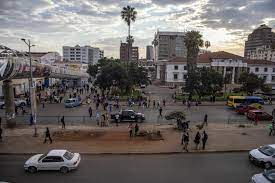Pedestrians and a highway in the central business district of Harare, Zimbabwe, on Wednesday, July 5, 2023. Consumer prices are climbing at an annual pace of over 100%, sparking jitters in a nation where the scars of hyperinflation run deep. , Bloomberg
(Bloomberg) — Zimbabwe needs to spend $4.4 billion on expanding access to electricity if it is to meet its goal of achieving upper middle-income status by 2030, according to the World Bank.
Power supply shortages are costing the southern African nation an estimated 6.1% of of its gross domestic product annually, the Washington-based lender said in its latest Zimbabwe Economic Report, released Wednesday. While an additional 600 megawatts of generation capacity was brought on line this year from the country’s coal-fired plants, frequent breakdowns at its other units led to blackouts that lasted an average of 12 hours a day.
Energy constraints translate “into lower economic growth and lower household incomes,” and are considered the “single biggest brake on the expansion of mining and mineral processing,” the bank said. It envisions the government financing 85% of the required expansion in electricity production, and consumers and the private sector funding 11% and 4% respectively.
Zimbabwe has installed power generation capacity of 2,100 megawatts, but its output is significantly lower than that. Electricity demand is set to grow to 5,177 megawatts by 2030, from 1,950 megawatts, the World Bank’s projections show.
The fastest and cheapest way to produce more power from 2024 to 2026 would be through solar plants, it said. “Subsequently, generation expansion efforts would comprise gas and hydropower power plants, in addition to more solar.”
Zimbabwe experienced its worst-ever outages last year, with blackouts imposed for as long as 19 hours each day, after a drop in water levels in the Kariba Dam curbed production from the country’s main hydropower plant.
Other highlights:
The economy is expected to grow 3.5% in 2024, down from 4.5% this year and 6.5% in 2022.
“Shocks from the war in Ukraine, supply chain disruptions, economic volatility, and power shortages have kept Zimbabwe’s economic activity below its potential for both 2022 and 2023.”
The expansion in gross domestic product since the start of last year, along with good harvests, helped bring down levels of poverty and food insecurity, although rates remain high.
“Zimbabwe’s economic outlook appears moderate, reflecting continued global headwinds, structural bottlenecks, weather-related shocks, and price and exchange-rate volatility.”
“Zimbabwe remains in debt distress and while borrowing is limited, public debt has continued to increase,” driven by external arrears and legacy debt.
Source Zimbabwe Situation










